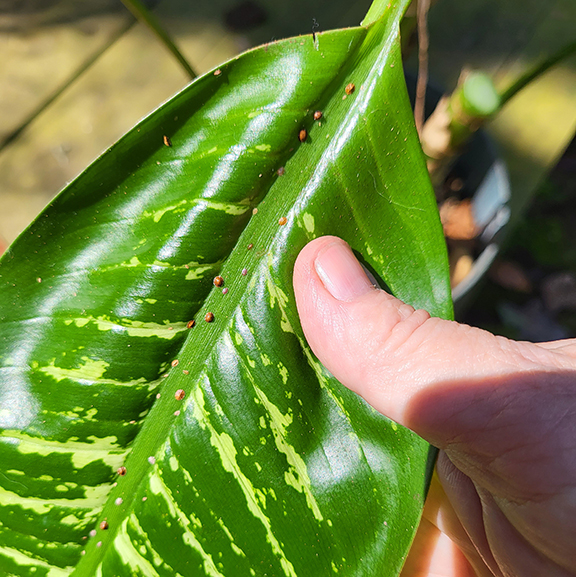Welcome!

Scale can be easy to overlook on a houseplant. It is a soft-bodied or hard-bodied insect that looks a lot like a little brown or tan lump.
Scales are the worst
It’s one of the great mysteries, right up there with “How did the universe begin?” or “Why do stupid people keep getting elected?”
In this case, I have to ask: How does an insect that rarely moves any better than a rock get on a houseplant that hasn’t been exposed to any other infected plant?
I had noticed that the dumbcane (Dieffenbachia) in my living room was a little piqued. I assumed it was because it needed repotting. The poor baby is almost 20 years old, after all. Imagine my surprise when, on closer inspection, I found it covered with scale. Where did the scale come from?
Scale can be either a soft-bodied or hard-bodied insect. It looks a lot like a little brown or tan lump. You might even mistake it as a feature of the plant unless you are really familiar with what your plant should look like.
The nymph form of scale is mobile briefly but quickly settles down as soon as it finds a food source. The insects on my plant seem to be the hard-bodied variety. Not that it matters. Both types do the same kind of damage to a plant. The insect pierces the leaf or stem tissue and suck nutrients from the plant.
Soft-bodied scale excretes honeydew. In other words, whatever sap it doesn’t digest gets pooped out. This in turn can cause black sooty mold on the plant that is infested. Some plant owners mistakenly focus on treating the mold when they should focus on getting rid of the insect. Since the scale on my plant is hard-bodied, mold isn’t a problem.
And I’m sad to say, it was probably me or the dog that infected my plant. Since scale is largely immobile (except in certain life stages), it can be moved from plant to plant by people, animals or wind. There’s no wind in the house, so the culprit in this crime was likely me or Noir. Who knows where Noir or I picked it up. Just because the scale started outdoors on some plant doesn’t mean it would turn its snout up at an indoor plant.
Once on the food source, scale can reproduce with abandon. Here’s the bad news, guys. Female scale don’t really need males to procreate. They can do just fine on their own. Given the level of infestation on my plant, I had one or more female scales determine to repopulate the world.
Fortunately, scale is one of the easiest pests to remove in an environmentally safe manner. In fact, the environmental remedies work better because most insecticides can’t penetrate the outer shell of scale insects.
All you need is some alcohol and soapy water. Soak a tissue in the alcohol and rub the tissue over the scale to dislodge it. The alcohol will penetrate the hard outer shell of the insect and the rubbing action will dislodge the pest. After wiping down the infested parts of the plant, go over it again with warm soapy water.
It is a good idea to repot the plant. Sometimes the insect can hide in the soil or the textured surface of the pot. Keep the treated plant away from other houseplants until you are sure you have all of the infestation taken care of. From that point on, it’s just a matter of giving your house buddy a little TLC to help it recover.
